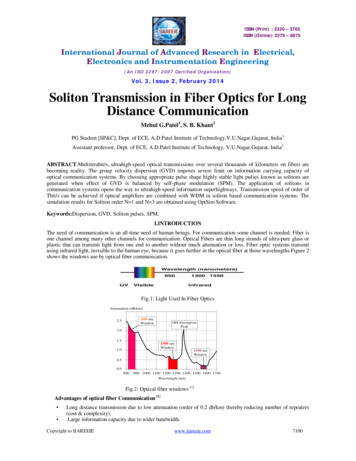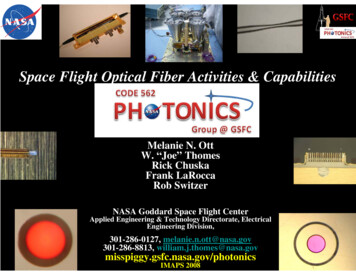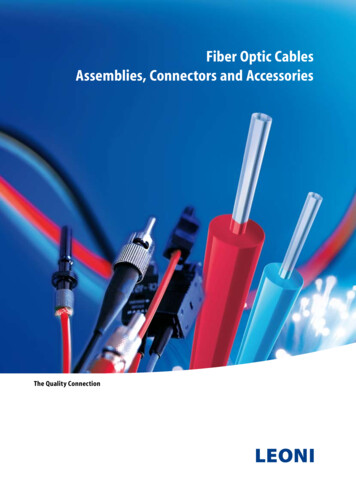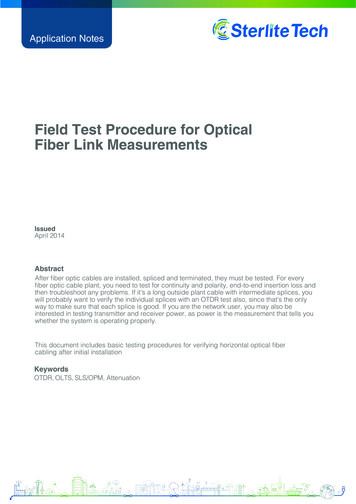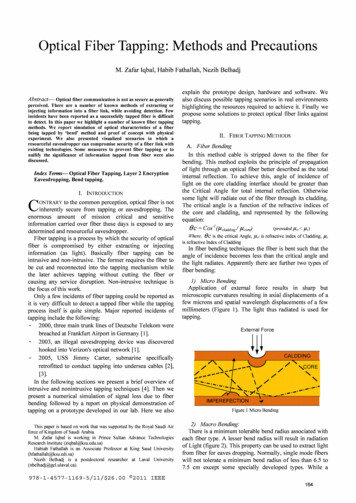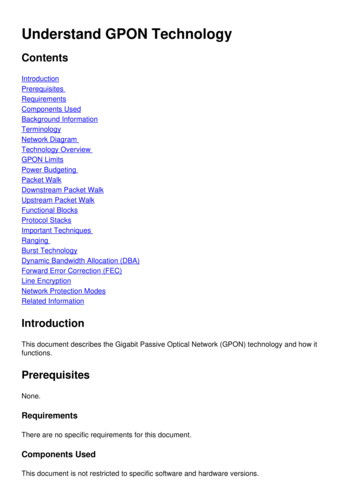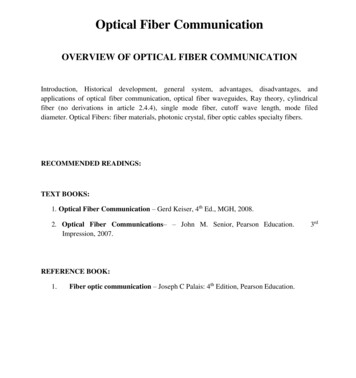
Transcription
Optical Fiber CommunicationOVERVIEW OF OPTICAL FIBER COMMUNICATIONIntroduction, Historical development, general system, advantages, disadvantages, andapplications of optical fiber communication, optical fiber waveguides, Ray theory, cylindricalfiber (no derivations in article 2.4.4), single mode fiber, cutoff wave length, mode fileddiameter. Optical Fibers: fiber materials, photonic crystal, fiber optic cables specialty fibers.RECOMMENDED READINGS:TEXT BOOKS:1. Optical Fiber Communication – Gerd Keiser, 4th Ed., MGH, 2008.2. Optical Fiber Communications– – John M. Senior, Pearson Education.Impression, 2007.REFERENCE BOOK:1.Fiber optic communication – Joseph C Palais: 4th Edition, Pearson Education.3rd
1.1.Historical Development Fiber optics deals with study of propagation of light through transparent dielectricwageguides. The fiber optics are used for transmission of data from point to pointlocation. Fiber optic systems currently used most extensively as the transmission linebetween terrestrial hardwired systems. The carrier frequencies used in conventional systems had the limitations in handlinmg thevolume and rate of the data transmission. The greater the carrier frequency larger theavailable bandwith and information carrying capacity.First generation The first generation of lightwave systems uses GaAs semiconductor laser and operatingregion was near 0.8 µm. Other specifications of this generation are as under:i)Bit rate: 45 Mb/sii)Repeater spacing: 10 kmSecond generationi) Bit rate: 100 Mb/s to 1.7 Gb/sii) Repeater spacing: 50 kmiii) Operation wavelength: 1.3 µmiv) Semiconductor: In GaAsPThird generationi) Bit rate: 10 Gb/sii) Repeater spacing: 100 kmiii) Operating wavelength: 1.55 µm
Fourth generationFourth generation uses WDM technique.Bit rate: 10 Tb/sRepeater spacing: 10,000 kmOperating wavelength: 1.45 to 1.62 µmFifth generationFifth generation uses Roman amplification technique and optical solitiors.Bit rate: 40 - 160 Gb/sRepeater spacing: 24000 km - 35000 kmOperating wavelength: 1.53 to 1.57 µmNeed of fiber optic communication Fiber optic communication system has emerged as most important communicationsystem. Compared to traditional system because of following requirements :1. In long haul transmission system there is need of low loss transmission medium2. There is need of compact and least weight transmitters and receivers.3. There is need of increase dspan of transmission.4. There is need of increased bit rate-distrance product. A fiber optic communication system fulfills these requirements, hence most widelyacception.1.2 General Optical Fiber Communication System Basic block diagram of optical fiber communication system consists of followingimportant blocks.1. Transmitter2. Information channel3. Receiver.
Fig. 1.2.1 shows block diagram of OFC system.Message origin : Generally message origin is from a transducer that converts a non-electrical message intoan electrical signal. Common examples include microphones for converting sound wavesinto currents and video (TV) cameras for converting images into current. For data transferbetween computers, the message is already in electrical form.Modulator : The modulator has two main functions.1) It converts the electrical message into the proper format.2) It impresses this signal onto the wave generated by the carrier source.Two distinct categories of modulation are used i.e. analog modulation and digitalmodulation.Carrier source : Carrier source generates the wave on which the information is transmitted. This wave iscalled the carrier. For fiber optic system, a laser diode (LD) or a light emitting diode(LED) is used. They can be called as optic oscillators, they provide stable, singlefrequency waves with sufficient power for long distance propagation.
Channel coupler : Coupler feeds the power into the information channel. For an atmospheric optic system,the channel coupler is a lens used for collimating the light emitted by the source anddirecting this light towards the receiver. The coupler must efficiently transfer themodulated light beam from the source to the optic fiber. The channel coupler design is animportant part of fiber system because of possibility of high losses.Information channel : The information channel is the path between the transmitter and receiver. In fiber opticcommunications, a glass or plastic fiber is the channel. Desirable characteristics of theinformation channel include low attenuation and large light acceptance cone angle.Optical amplifiers boost the power levels of weak signals. Amplifiers are needed in verylong links to provide sufficient power to the receiver. Repeaters can be used only fordigital systems. They convert weak and distorted optical signals to electrical ones andthen regenerate the original disgital pulse trains for further transmission. Another important property of the information channel is the propagation time of thewaes travelling along it. A signal propagating along a fiber normally contains a range ofoptic frequencies and divides its power along several ray paths. This results in adistortion of the propagating signal. In a digital system, this distortion appears as aspreading and deforming of the pulses. The spreading is so great that adjacent pulsesbegin to overlap and become unrecognizable as separate bits of information.Optical detector : The information being transmitted is detector. In the fiber system the optic wave isconverted into an electric current by a photodetector. The current developed by thedetector is proportional to the power in the incident optic wave. Detector output currentcontains the transmitted information. This detector output is then filtered to remove theconstant bias and thn amplified. The important properties of photodetectors are small size, economy, long life, low powerconsumption, high sensitivity to optic signals and fast response to quick variations in theoptic power.
Signal processing : Signal processing includes filtering, amplification. Proper filtering maximizes the ratio ofsignal to unwanted power. For a digital system decision circuit is an additional block. Thebit error rate (BER) should be very small for quality communications.Message output : The electrical form of the message emerging from the signal processor are transformedinto a soud wave or visual image. Sometimes these signals are directly usable whencomputers or other machines are connected through a fiber system.1.3 Advantages of Optical Fiber Communications1. Wide bandwidth The light wave occupies the frequency range between 2 x 1012 Hz to 3.7 x 1012 Hz.Thus the information carrying capability of fiber optic cables is much higher.2. Low losses Fiber optic cables offers bery less signal attenuation over long distances. Typically it isless than 1 dB/km. This enables longer distance between repeaters.3. Immune to cross talk Fiber optic cables has very high immunity to electricaland magnetic field. Since fiberoptic cables are non-conductors of electricity hence they do not produce magnetic field.Thus fiber optic cables are immune to cross talk between cables cause dby magneticinduction.4. Interference immune Fiber optic cable sar eimmune to conductive and radiative interferences caused byelectrical noise sources such as lighting, electric motors, fluorescent lights.5. Light weight As fiber cables are made of silica glass or plastic which is much lighter than copper oraluminium cables. Light weight fiber cables are cheaper to transport.
6. Small size The diameter of fiber is much smaller compared to other cables, therefore fiber calbe issmall in size, requires less storage space.7. More strength Fiber cables are stronger and rugged hence can support more weight.8. Security Fiber cables are more secure than other cables. It is almost impossible to tap into a fibercable as they do n ot radiate signals.No ground loops exist between optical fibers hence they are more secure.9. Long distance transmission Becaujse of less attenuation transmission at a longer distance is possible.10. Environment immune Fiber calbes are more immune to environmental extremes. They can operate over a largetemperature varioations. Also they are not affected by corrosive liquids and gases.11. Sage and easy installation Fiber cables are safer and easier to install and maintain. They are non-conductors hencethere is no shock hazards as no current or voltage is associated with them. Their smallsize and light weight feature makes installation easier.12. Less cost Cost of fiber optic system is less compated to any other system.1.4 Disadvantages of Optical Fiber Communicaitons1. High initial cost The intial cost of installation or setting up cost is very high compared to all other system.2. Maintenance and repaiding cost
The maintenance and repaiding of fiber optic systems is not only difficult but expensivealso.3. Jointing and test procedures Since optical fibers are of very small size. The fiber joining process is very constly andrequires skilled manpower.4. Tensile stress Optical fibers are more susceptible to buckling, bending and tensile stress than coppercables. This leades to restricted practice to use optical fiber technology to premises andfloor backbones with a few interfaces to the copper cables.5. Short links Eventhough optical fiber calbes are inexpensive, it is still not cost effective to replaceevery small conventional connector (e.g. between computers and peripherals), as theprice of optoelectronic transducers are very high.6. Fiber losses The amount of optical fiber available to the photodetector at the end of fiber lengthdepends on various fiber losses such as scattering, dispersion, attenuation and reflection.1.5 Applications of Optical Fiber Communicaitons Applications of optical fiber communications include telecommunications, datacommunications, video control and protection switching, sensors and power applications.1. Telephone networks Optical waveguide has low attenuation, high transmission bandwidth compated to copperlines, therefore numbers of long haul co-axial trunks l;links between telephone exchangesare being replaced by optical fiber links.2. Urban broadband service networks Optical waveguide provides much larger bandwidth than co-axial calbe, also the numberof repeaters required is reduced considerably.
oconferencingvideotelephony, switched broadband communication network. All these can be suppliedover a single fiber optic link. Fiber optic calbes is the solution to many of today’s highspeed, high bandwidth data communication problems and will continue to play a largerole in future telecom and data-com networks.1.6 Optical Fiber Waveguides In free space light ravels as its maximum possible speed i.e. 3 x 108 m/s or 186 x 103miles/sec. When light travels through a material it exnibits certain behavior explaned bylaws of reflection, refraction.Electromagnetic Spectrum The radio waves and light are electromagnetic waves. The rate at which they alternate inpolarity is called their frequency (f) measured in hertz (Hz). The speed of electromagneticwave (c) in free space is approximately 3 x 108 m/sec. The distance travelled during eachcycle is called as wavelength (λ) In fiber optics, it is more convenient to use the wavelength of light instead of thefrequency with light frequencies, wavlengfth is often stated in microns or nanometers.1 micron (µ) 1 Micrometre (1 x 10-6)1 nano (n) 10-9 metreFig. 1.6.1 shows electromagnetic frequency spectrum.
Fiber optics uses visible and infrared light. Infrared light covers a fairly wide range ofwavelengths and is generally used for all fiber optic communications. Visible light isnormally used for very short range transmission using a plastic fiber.Ray Transmission Theory Before studying how the light actually propagates through the fiber, laws governing thenature of light m ust be studied. These was called as laws of optics (Ray theory). Thereis conception that light always travels at the same speed. This fact is simply not true. Thespeed of light depends upon the material or medium through which it is moving. In freespace light travels at its maximum possible speed i.e. 3 x 108 m/s or 186 x 103 miles/sec.When light travels through a material it exhibits certain behavior explained by laws ofreflection, refraction.Reflection The law of reflection states that, when a light ray is incident upon a reflective surface atsome incident angle 1 from imaginary perpendicular normal, the ray will be reflectedfrom the surface at some angle 2 from normal which is equal to the angle of incidence.Fig. 1.6.2 shows law of relection.
Refraction Refraction occurs when light ray passes from one medium to another i.e. the light raychanges its direction at interface. Refractio occurs whenever density of medium changes.E.g. refraction occurs at air and water interface, the straw in a glass of water will appearas it is bent.The refraction can also observed at air and glass interface. When wave passes through less dense medium to more dense medium, the wave isrefracted (bent) towards the normal. Fig. 1.6.3 shows the refraction phenomena. The refraction (bending) takes place because light travels at different spped in differentmediums. The speed of light in free space is higher than in water or glass.
Refractive Index The amount of refraction or bending that occurs at the interface of two materials ofdifferent densities is usually expressed as refractive index of two materials. Refractiveindex is also known as index of refraction and is denoted by n. Based on material density, the refractive index is expressed as the ratio of the velocity oflight in free space to the velocity of light of the dielectric material (substance).The refractive index for vacuum and air os 1.0 for water it is 1.3 and for glass refractiveindex is 1.5.Snell’s Law Snell’s law states how light ray reacts when it meets the interface of two media havingdifferent indexes of refraction. Let the two medias have refractive indexes n1 and n2 where n1 n2. 1 and 2 be the angles of incidence and angle of refraction respectively. Then accordingto Snell’s law, a relationship exists between the refractive index of both materials given by, (1.6.1) A refractive index model for Snell’s law is shown in Fig. 1.6.4.
The refracted wave will be towards the normal when n1 n2 and will away from it whenn1 n2.Equation (1.6.1) can be written as, This equation shows that the ratio of refractive index of two mediums is inverselyproportional to the refractive and incident angles.As refractive indexandsubstituting these values in equation (1.6.2)Critical Angle When the angle of incidence ( 1) is profressively increased, there will be progressiveincrease of refractive angle ( 2). At some condition ( 1) the refractive angle ( 2) becomes90o to the normal. When this happens the refracted light ray travels along the interface.The angle of incidence ( 1) at the point at which the refractive angle ( 1) becomes 90o iscalled the critical angle. It is denoted by c. The critical angle is defined as the minimum angle of incidence ( 1) at which the raystrikes the interface of two media and causes an agnle of refraction ( 2) equal to 90o. Fig1.6.5 shows critical angle refraction.
Hence at critical angle 1 c and 2 90oUsing Snell’s law : n1 sin 1 n2 sin 2Therefore, (1.6.3) The actual value of critical angle is dependent upon combination of materials present oneach side of boundary.Total Internal Refleciton (TIR) When the incident angle is increase dbeyond the critical angle, the light ray does not passthrough the interface into the other medium. This gives the effect of mirror exist at theinterface with no possibility of light escaping outside the medium. In this condition angleof reflection ( 2) is equal to angle of incidence ( 1). This action is called as TotalInternal Reflection (TIR) of the beam. It is TIR that leads to the propagation of waveswithin fiber-cable medium. TIR can be observed only in materials in which the velocityof light is less than in air. The two conditions necessary for TIR to occur are :
1. The refractive index of first medium must be greater than the refractive index of secondone.2. The angle of incidence must be greater than (or equal to) the critical angle.Example 1.6.1 : A light ray is incident from medium-1 to medium-2. If the refractive indices ofmedium-1 and medium-2 are 1.5 and 1.36 respectively then determine the angle of refraction foran angle of incidence of 30o.Solution : Medium-1 n1 1.5Medium-2 n2 1.36Angle of incidence 1 30o.Angle of incident 2 ?Angle of refraction 33.46o from normal.Example 1.6.2 : A light ray is incident from glass to air. Calculate the critical angle ( c).Solution : Refractive index of glass n1 1.50Refrative indes of air n2 1.00From definition of critical angle, 2 90o and 1 c. Ans.
Ans.Example 1.6.3 : Calculate the NA, acceptance angle and critical angle of the fiber having n1(Core refractive index) 1.50 and refractive index of cladding 1.45.Soluiton : n1 1.50, n2 1.45
Optical Fiver as Waveguide An optical fiber is a cylindrical dielectric waveguide capable of conveyingelectromagnetic waves at optical frequencies. The electromagnetic energy is in the formof the light and propagates along the axis of the fiber. The structural of the fiverdetermines the transmission characteristics.The propagation of light along the waveguide is decided by the modes of the waveguides,here mode means path. Each mode has distict pattern of electric and magnetic fielddistributions along the fiber length. Only few modes can satisfy the homogeneous waveequation in the fiver also the boundary condition a waveguide surfaces. When there isonly one path for light to follow then it is called as single mode propagation. When thereis more than one path then it is called as multimode propagation.Single fiber structure A single fiber structure is shown in Fig. 1.6.6. It consists of a solid dielectric cylinderwith radius ‘a’. This cylinder is called as core of fiber. The core is surrounded bydielectric, called cladding. The index of refraction of core (glass fiber) is slightly greaterthan the index of refraction of cladding.If refractive index of core (glass fiver) n1and refractive index of cladding n2then n1 n2.Propagation in Optical Fiber To understand the general nature of light wave propagation in optical fiber. We firstconsider the construction of optical fiber. The innermost is the glass core of very thindiameter with a slight lower refractive index n2. The light wave can propagate along sucha optical fiber. A single mode propagation is illustrated in Fig. 1.6.7 along with standardsize of fiber.
Single mode fibers are capable of carrying only one signal of a specific wavelength.In multimode propagation the light propagates along the fiber in zigzag fashion, providedit can undergo total internal reflection (TIR) at the core cladding boundaries.Total internal reflection at the fiber wall can occur only if two conditions are satisfied.Condition 1:The index of refraction of glass fiber must be slightly greater than the index of refraction ofmaterial surrounding the fiber (cladding).If refractive index of glass fiber n1and refractive index of cladding n2then n1 n2.Condition 2 :The angle of incidence ( 1 of light ray must be greater than critical angle ( c). A light beam is focused at one end of cable. The light enters the fibers at different angles.Fig. 1.6.8 shows the conditions exist at the launching end of optic fiber. The light sourceis surrounded by air and the refractive index of air is n0 1. Let the incident ray makes anangle 0 with fiber axis. The ray enters into glass fiber at point P making refracted angle 1 to the fiber axis, the ray is then propagated diagonally down the core and reflect fromthe core wall at point Q. When the light ray reflects off the inner surface, the angle ofincidence is equal to the angle of reflection, which is greater than critical angle.In order for a ray of light to propagate down the cable, it must strike the core claddinginterface at an angle that is greater than critical angle ( c).
Acceptance AngleApplying Snell’s law to external incidence angle.n0 sin 0 n1 sin 1But 1 (90 - c)sin 1 sing (90 - c) cos cSubstituting sin 1 in above equation.n0 sin 0 n1 cos cApplying Pythagorean theorem to ΔPQR.
The maximum value of external incidence angle for which light will propagate in thefiber.When the light rays enters the fivers from an air medium n0 1. Then above equationreduces to,The angle 0 is called as acceptance angle anddefines the maximum angle inwhich the light ray may incident on fiber to propagate down the fiber.Acceptance Cone Rotating the acceptance anglearound the fiber axis, a cone shaped pattern isobtained, it is called as acceptance cone of the fiber input. Fig 1.6.10 shows formation ofacceptance cone of a fiber cable.
The Cone of acceptance is the angle within which the light is accepted into the core andis able to travel along the fiber. The launching of light wave becomes easier for largeacceptance come.The angle is measured from the axis of the positive cone so the total angle ofconvergence is actually twice the stated value.Numerical Aperture (NA) The numerical aperture (NA) of a fiber is a figure of merit which represents its lightgathering capability. Larger the numerical aperture, the greater the amount of lightaccepted by fiber. The acceptance angle also determines how much light is able to beenter the fiber and hence there is relation between the numerical aperture and the cone ofacceptance.Numerical aperture (NA) sinFor airno 1 (1.6.4)Hence acceptance angle sin-1 NA
By the formula of NA note that the numerical aperture is effectively dependent only onrefractive indices of core and cladding material. NA is not a function of fiber dimension. The index difference (Δ) and the numerical aperture (NA) are related to the core andcladding indices:(1.6.5 (a)). (1.6.5 (b))AlsoExample 1.6.5 : Calculate the numerical aperture and acceptance angle for a fiber cable of whichncore 1.5 and ncladding 1.48. The launching takes place from air.Solution :NA 0.244Acceptance angle - Ans.
Acceptance angle sin-1 0.244 0 14.12o Ans.Types of Rays If the rays are launched within core of acceptance can be successfully propagated alongthe fiber. But the exact path of the ray is determined by the position and angle of ray atwhich it strikes the core.There exists three different types of rays.i) Skew raysii) Meridional raysiii) Axial rays.The skew rays does not pass through the center, as show in Fig. 1.6.11 (a). The skewrays reflects off from the core cladding boundaries and again bounces around the outsideof the core. It takes somewhat similar shape of spiral of helical path.The meridional ray enters the core and passes through its axis. When the core surfaceis parallel, it will always be reflected to pass through the enter. The meridional ray isshown in fig. 1.6.11 (b).The axial ray travels along the axis of the fiber and stays at the axis all the time. It isshown in fig. 1.6.11 (c).
Modes of Fiber Fiber cables cal also be classified as per their mode. Light rays propagate as anelectromagnetic wave along the fiber. The two components, the electric field and themagnetic field form patterns across the fiber. These patterns are called modes oftransmission. The mode of a fiber refers to the number of paths for the light rays withinthe cable. According to modes optic fibers can be classified into two types.i) Single mode fiber ii) Multimode fiber.Multimode fiber was the first fiber type to be manufactured and commercialized. Theterm multimode simply refers to the fact that numerous modes (light rays) are carriedsimultaneously through the waveguide. Multimode fiber has a much larger diameter,compared to single mode fiber, this allows large number of modes.Single mode fiber allows propagation to light ray by only one path. Single mode fibersare best at retaining the fidelity of each light pulse over longer distance also they do notexhibit dispersion caused by multiple modes.Thus more information can be transmitted per unit of time.This gives single mode fiber higher bandwidth compared to multimode fiber. Some disadvantages of single mode fiber are smaller core diameter makes couplinglight into the core more difficult. Precision required for single mode connectors andsplices are more demanding.Fiber Profiles A fiber is characterized by its profile and by its core and cladding diameters.One way of classifying the fiber cables is according to the index profile at fiber. Theindex profile is a graphical representation of value of refractive index across the corediameter.There are two basic types of index profiles.i) Step index fiber.ii) Graded index fiber.Fig. 1.6.12 shows the index profiles of fibers.
Step Index (SI) Fiber The step index (SI) fiber is a cylindrical waveguide core with central or inner core hasa uniform refractive index of n1 and the core is surrounded by outer cladding withuniform refractive index of n2. The cladding refractive index (n2) is less than the corerefractive index (n1). But there is an abrupt change in the refractive index at the corecladding interface. Refractive index profile of step indexed optical fiber is shown in Fig.1.6.13. The refractive index is plotted on horizontal axis and radial distance from the coreis plotted on vertical axis. The propagation of light wave within the core of step index fiber takes the path ofmeridional ray i.e. ray follows a zig-zag path of straight line segments.The core typically has diameter of 50-80 µm and the cladding has a diameter of 125 µm.The refractive index profile is defined as –
Graded Index (GRIN) Fiber The graded index fiber has a core made from many layers of glass.In the graded index (GRIN) fiber the refractive index is not uniform within the core,it is highest at the center and decreases smoothly and continuously with distance towardsthe cladding. The refractive index profile across the core takes the parabolic nature. Fig.1.6.14 shows refractive index profile of graded index fiber. In graded index fiber the light waves are bent by refraction towards the core axis andthey follow the curved path down the fiber length. This results because of change inrefractive index as moved away from the center of the core.A graded index fiber has lower coupling efficiency and higher bandwidth than the stepindex fiber. It is available in 50/125 and 62.5/125 sizes. The 50/125 fiber has beenoptimized for long haul applications and has a smaller NA and higher bandwidth.62.5/125 fiber is optimized for LAN applications which is costing 25% more than the50/125 fiber cable.The refractive index variation in the core is giver by relationship where,r Radial distance from fiber axisa Core radiusn1 Refractive index of core
n2 Refractive index of claddingα Shape of index profile. Profile parameter α determines the characteristic refractive index profile of fiber core.The range of refractive index as variation of α is shown in Fig. 1.6.15.Comparison of Step Index and Graded Index FiberSr. No.1.2.ParameterData rateCoupling efficiencyStep index fiberSlow.Coupling efficiency with fiberis higher.By total internal reflection.Graded index fiberHigherLower coupling efficiency.3.Ray path4.Index variation5.Numerical apertureNA remains same.6.Material used7.8.BandwidthefficiencyPulse spreadingNormally plastic or glass ispreferred.10 – 20 MHz/kmChanges continuously withdistance from fiber axis.Only glass is preferred.9.Attenuation of lightLightraytravelsoscillatory fashion.1 GHz/kmPulse spreading by fiber Pulse spreading is lesslength is more.Less typically 0.34 dB/km atMore 0.6 to 1 dB/km at 1.31.3 µm.µm.in
10.11.Typical light sourceApplicationsLED.Subscriber localcommunication.LED, Lasers.network Localandnetworks.wideareaOptic Fiber Configurations Depending on the refractive index profile of fiber and modes of fiber there exist threetypes of optical fiber configurations. These optic-fiber configurations are i) Single mode step index fiber.ii) Multimode step index fiber.iii) Multimode graded index fiber.Single mode Step index Fiber In single mode step index fiber has a central core that is sufficiently small so that thereis essentially only one path for light ray through the cable. The light ray is propagated inthe fiber through reflection. Typical core sizes are 2 to 15 µm. Single mode fiber is alsoknown as fundamental or monomode fiber.Fig. 1.6.16 shows single mode fiber. Single mode fiber will permit only one mode to propagate and does not suffer frommode delay differences. These are primarily developed for the 1300 nm window but theycan be also be used effectively with time division multiplex (TDM) and wavelengthdivision multiplex (WDM) systems operating in 1550 nm wavelength region.The core fiber of a single mode fiber is very narrow compared to the wavelength oflight being used. Therefore, only a single path exists through the cable core throughwhich light can travel. Usually, 20 percent of the light in a single mode cable actually
travels down the cladding and the effective diameter of the cable is a blend of singlemode core and degree to which the cladding carries light. This is referred to as the ‘modefield diameter’, which is larger than physical diameter of the core depending on therefractive indices of the core and cladding.The disadvantage of this type of cable is that because of extremely small sizeinterconnection of cables and interfacing with source is difficult. Another disadvantage ofsingle mode fibers is that as the refractive index of glass decreases with opticalwavelength, the light velocity will also be wavelength dependent. Thus the light from anopt
applications of optical fiber communication, optical fiber waveguides, Ray theory, cylindrical fiber (no derivations in article 2.4.4), single mode fiber, cutoff wave length, mode filed . RECOMMENDED READINGS: TEXT BOOKS: 1. thOptical Fiber Communication - Gerd Keiser, 4 Ed., MGH, 2008. 2. Optical Fiber Communications- - John M. Senior .
